
Horologium is a constellation of six stars faintly visible in the southern celestial hemisphere. It was first described by the French astronomer Nicolas-Louis de Lacaille in 1756 and visualized by him as a clock with a pendulum and a second hand. In 1922 the constellation was redefined by the International Astronomical Union (IAU) as a region of the celestial sphere containing Lacaille's stars, and has since been an IAU designated constellation. Horologium's associated region is wholly visible to observers south of 23°N.

Omega Virginis is a solitary star in the zodiac constellation Virgo. It has an apparent visual magnitude of +5.2, which is bright enough to be faintly visible to the naked eye. Based upon an annual stellar parallax shift of 6.56 milliarcseconds, it is located about 500 light years from the Sun.

Theta Apodis is a variable star in the southern circumpolar constellation of Apus. It is a variable star with an apparent visual magnitude range of 4.65 to 6.20, which, according to the Bortle Dark-Sky Scale, means it is a faint star but visible to the naked eye from dark suburban skies. The distance to Theta Apodis is approximately 350 light-years, based upon parallax measurements made from the Gaia telescope. It is unusual in that it is a red star with a high proper motion.

Mu1 Cancri, Latinised from μ1 Cancri, is a variable star in the zodiac constellation of Cancer. The name Mu1 comes from the Bayer naming system: the "1" in the name is because (from Earth) it appears to be close to 10 Cancri, or Mu2 Cancri. It is also known by the variable star designation BL Cancri. The star is dimly visible to the naked eye with an apparent visual magnitude that ranges from 5.87 down to 6.07. Parallax measurements put it about 630 light-years (192 parsecs) from the Sun. At that distance, the visual magnitude is diminished by an extinction factor of 0.28. The position of the star near the ecliptic means it is subject to lunar occultations.
27 Cancri is a single star in the zodiac constellation of Cancer, located around 990 light-years away from the Sun. It is visible to the naked eye as a faint, red-hued star with a typical apparent visual magnitude of around +5.56. The star is moving closer to the Earth with a heliocentric radial velocity of −8.3 km/s. It is a member of the Arcturus stream, a group of stars with high proper motion and metal-poor properties thought to be the remnants of a small galaxy consumed by the Milky Way.
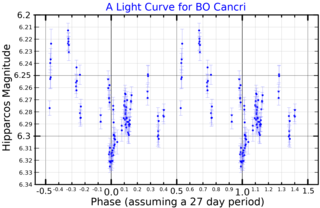
53 Cancri is a variable star in the zodiac constellation Cancer, located around 960 light years from the Sun. It has the variable star designation BO Cancri; 53 Cancri is the Flamsteed designation. This object is a challenge to view with the naked eye, having an apparent visual magnitude around 6. It is around 960 light years away.

R Andromedae is a Mira-type variable star in the constellation Andromeda. Its spectral class is type S because it shows absorption bands of zirconium monoxide (ZrO) in its spectrum. It was among the stars found by Paul Merrill to show absorption lines of the unstable element technetium, establishing that nucleosynthesis must be occurring in stars. The SH molecule was found for the first time outside earth in the atmosphere of this star. The star is losing mass due to stellar winds at a rate of 1.09×10−6M☉/yr.

V Aquilae is a carbon star and semiregular variable star in the constellation Aquila. It has an apparent magnitude which varies between 6.6 and 8.4 and is located around 400 parsecs (1,300 ly) away.

NO Aurigae is a pulsating variable star in the constellation Auriga. It is an unusually-luminous asymptotic giant branch star about 3,500 light years away.

HD 128333 or CH Boötis is an irregular variable star in the northern constellation of Boötes. It is currently on the asymptotic giant branch of the HR diagram.
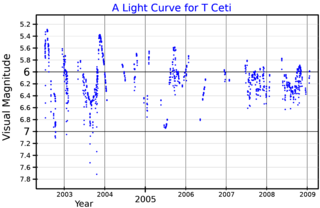
T Ceti is a semiregular variable star located in the equatorial constellation of Cetus. It varies between magnitudes 5.0 and 6.9 over 159.3 days. The stellar parallax shift measured by Hipparcos is 3.7 mas, which yields a distance estimate of roughly 900 light years. It is moving further from the Earth with a heliocentric radial velocity of +29 km/s.
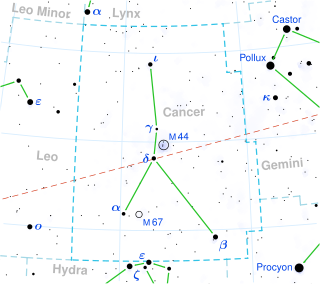
X Cancri is a variable star in the northern constellation of Cancer. It has a red hue and is visible to the naked eye at its brightest. The distance to this object is approximately 1,860 light years based on parallax measurements, but is drifting closer with a radial velocity of −5 km/s. It lies very close to the ecliptic and so is subject to lunar occultations.
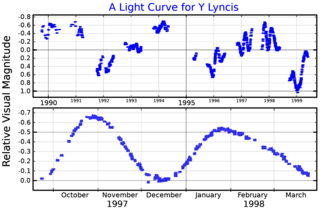
Y Lyncis is a semiregular variable star in the constellation Lynx. It is an asymptotic giant branch star of spectral type M6S, with a luminosity class of Ib, indicating a supergiant luminosity. It is around 1,160 light years away.

W Orionis is a carbon star in the constellation Orion, approximately 400 parsecs (1,300 ly) away. It varies regularly in brightness between extremes of magnitude 4.4 and 6.9 roughly every 7 months.

II Lupi is a Mira variable and carbon star located in the constellation Lupus. It is the brightest carbon star in the southern hemisphere at 12 μm.

V Crucis is a carbon star in the constellation Crux. A Mira variable, its apparent magnitude ranges from 8.7 to 11.1 over 376.5 days. The fact that this star's period is nearly equal to one year makes it hard to get good observational coverage over the entire cycle. Its near-infrared light curve shows a contribution from the first harmonic of the fundamental period.

HV 888, also known as WOH S140, is a red supergiant (RSG) star located in the Large Magellanic Cloud. It is possibly among the largest known stars, with reliable estimates of its radius ranging from 1,353 R☉ to 1,584 R☉, and is also one of the most luminous of its type with a range of nearly 300,000 to over 500,000 times that of the Sun (L☉). The effective temperature is estimated to be around 3,500 K. If placed at the center of the Solar System, its photosphere would engulf the orbit of Jupiter.

Y Tauri is a carbon star located in the constellation Taurus. Parallax measurements by Gaia put it at a distance of approximately 2,170 light-years.
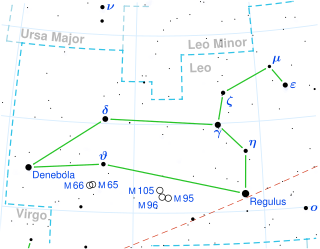
56 Leonis is a red giant variable star located approximately 390 light years away in the constellation Leo.
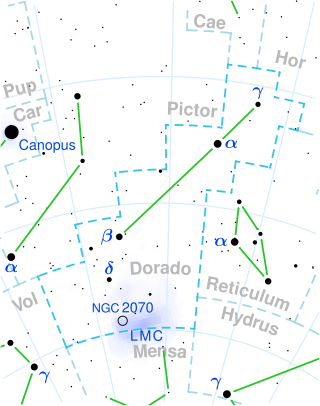
WZ Doradus is a solitary red-hued variable star located in the southern constellation Dorado. It has an average apparent magnitude of 5.21, making it faintly visible to the naked eye under ideal conditions. Gaia DR3 parallax measurements imply a distance of 580 light-years and it is currently receding with a heliocentric radial velocity of 19.3 km/s. At its current distance, WZ Doradus is diminished by two-tenths of a magnitude due to interstellar extinction and it has an absolute magnitude of −1.00.



















